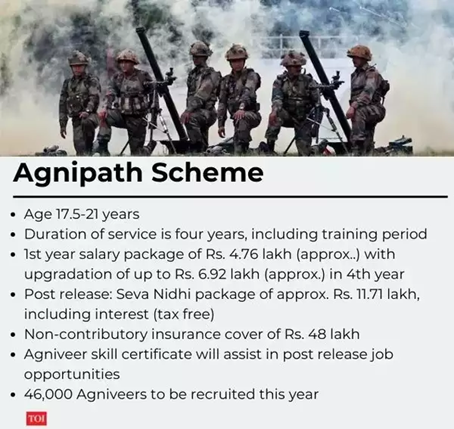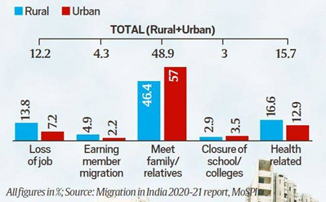Monday, 20th June 2022
Auctioning 5G spectrum bands - Edukemy Current Affairs
In News
Recently, the Union Cabinet gave its nod for the auction of spectrum that can be used to offer 5G services.
About the News
- A total of 72 Ghz of spectrum with a validity period of 20 years will be put on sale during the auction planned towards the end of July, 20222.
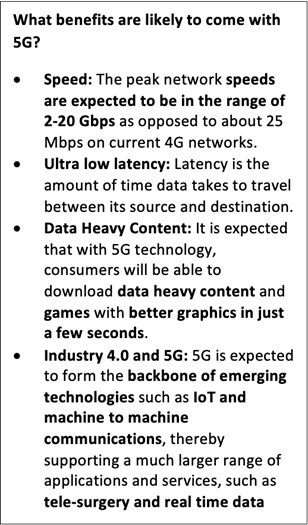
- The auction will be held for spectrum in various Low (600 MHz, 700 MHz, 800 MHz, 900 MHz, 1800 MHz, 2100 MHz, 2300 MHz), Mid (3300 MHz) and High (26 GHz) frequency bands.
- It is expected that the Mid and High band spectrum will be utilised by telecom service providers (TSPs) to roll-out 5G services wherein speeds would be 10 times higher than 4G services.
- Government has reserved a portion of airwaves for captive private networks, a proposal opposed by telecom service providers.
- As per a report by a government panel on 5G, even after the entry of 5G into the Indian networks, the earlier generation mobile technologies — 2G, 3G and 4G, will continue to remain in use and may take 10 or more years to phase out.
- 5G is expected to create a cumulative economic impact of $1 trillion in India by 2035.
Concerns raised against the Auctions
- High reserve prices for the spectrum: While the TRAI had recommended reducing prices of airwaves across various bands by 35-40% from its earlier proposed base price, the telecom operators had expressed disappointment given their demand for a 90% cut in the prices.
- The government has accepted the recommendations given by TRAI to reserve prices for spectrum auctions.
- Direct allotment of spectrum for Captive Private Networks: The Cellular Operators Association of India (COAI) has expressed that this provision will severely degrade the business case of Telecom Service Providers (TSPs).
- This stems from their concern that 5G technology has more industry use cases than individual consumers. So, telcos worry that providing industries 5G spectrum allocation to set up private networks will diminish their own revenue from the next generation of cellular services.
What are captive private networks and why do they need spectrum bands?
- Private wireless networks are cellular networks built specifically for individual enterprises. These networks are often deployed at a single unit, for example, a factory or to monitor a mine in real-time.
- Airports and ports can also have their own private 5G cellular network to process imaging data coming from surveillance cameras to manage the facility.
- The key reason for its high scale adoption is the need for greater data privacy and security. Unlike unlicensed Wi-Fi service available in several private places, licensed spectrum bands offer greater data privacy, security and faster connection speeds.
- The Department of Telecommunications (DoT) has said that private firms can set up a 5G network by either getting a slice of the public network from a licensed telecom company, establishing an isolated on-premise network from the telecom service provider’s spectrum, or obtaining spectrum directly from the Department of Telecom or by sub-leasing it from telcos.
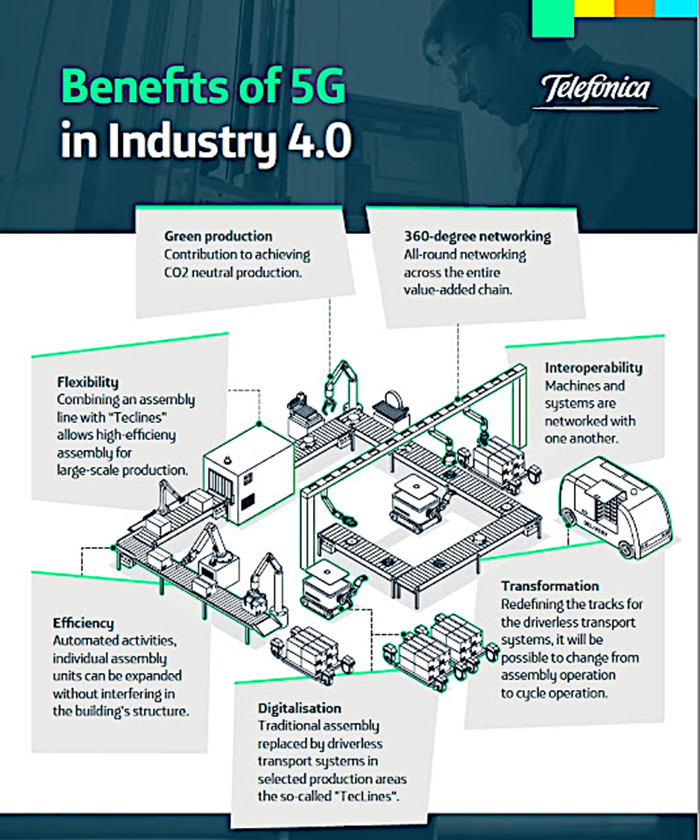
Sources:
Presidential Election in India
In News
Fifteen candidates have filed their nominations recently for the presidential election with the papers of three of them rejected for want of proper documents.
About the News
- The poll to elect the successor to incumbent President of India will be held on July 18 for which the nomination process has begun.
- The 2022 presidential election will be the 16th presidential election to be held in India.
- The elections are conducted and overseen by the Election Commission (EC) of India.
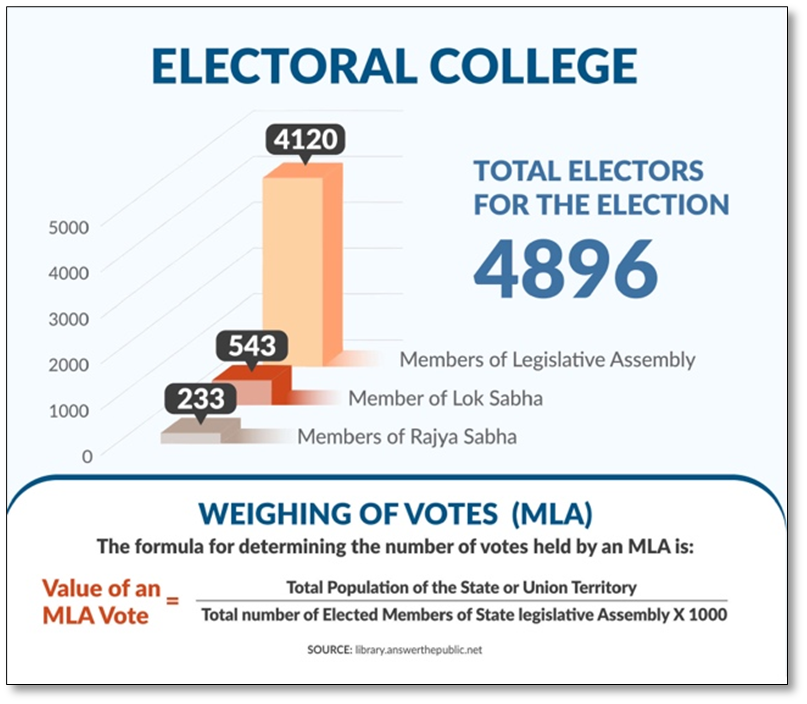
Presidential Election in India
- Background: The first presidential election in India after Independence was held on May 2, 1952 in which Rajendra Prasad, was elected the President.
- He is the only person till date to hold the President’s office for two terms.
How is the President elected in India?
- Electoral College: The Indian President is elected through an electoral college system, wherein the votes are cast by national and State-level lawmakers.
- The electoral college is made up of all the elected members of the Upper and Lower Houses of Parliament (Rajya Sabha and Lok Sabha MPs), and the elected members of the Legislative Assemblies of States and Union Territories (MLAs).
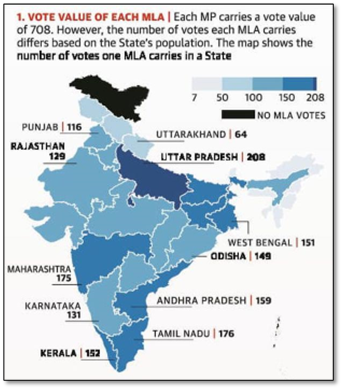
Process of Election
- Before the voting, comes the nomination stage, where the candidate intending to stand in the election, files the nomination along with a signed list of 50 proposers and 50 seconders.
- These proposers and seconders can be anyone from the total members of the electoral college from the State and national level.
- An elector cannot propose or second the nomination of more than one candidate.
- The rule for securing 50 proposers and seconders was implemented to avoid nominations by non-serious candidates whose chance of winning is bleak.
What is the value of each vote and how is it calculated?
- A vote cast by each MP or MLA is not calculated as one vote. There is a larger vote value attached to it.
- The fixed value of each vote by an MP of the Rajya Sabha and the Lok Sabha is
- The value of each MLA’s vote is determined by dividing the population of the State by the number of MLAs in its legislative Assembly, and the quotient achieved is further divided by 1000.
- Uttar Pradesh for instance, has the highest vote value for each of its MLAs, at The value of one MLA’s vote in Maharashtra is 175, while that in Arunachal Pradesh is just 8.
- The total votes of each Legislative Assembly are calculated by multiplying the vote value of each MLA by the number of MLAs.
- As per the Constitution (Eighty-fourth Amendment) Act 2001, currently, the population of States is taken from the figures of the 1971 Census which will change after the 2026 Census.
Declaration of victory
- A nominated candidate does not secure victory based on a simple majority but through a system of bagging a specific quota of votes.
- While counting, the EC totals up all the valid votes cast by the electoral college through paper ballots and to win, the candidate must secure 50% of the total votes cast + 1.
- Unlike general elections, where electors vote for a single party’s candidate, the voters of the electoral college write the names of candidates on the ballot paper in the order of preference.
- The President’s electionis held in accordance with the system of proportional representation by means of the single transferable vote and the voting is by secret ballot.
Source:
- Presidential election: 15 nominations filed, three rejected so far
- 15 nominations filed so far for July 18 presidential election
Image source:
Barents Sea Warming - Edukemy Current Affairs
In News
As per a recent study published by the Norwegian Meteorological Institute, parts of the Arctic region near Norway has been warming at as much as seven times the rate of warming in the rest of the world.
About the News
- The region around the northern Barents Seahas been warming two to two-and-a-half times the average warming of the Arctic region and five to seven times the warming in the rest of the world.
- Such intense warming has never been observed in the Arctic region before which is leading to the phenomenon of
Atlantification
- Scientists have discovered‘hotspots’ where some parts of the Barents Sea have started closely resembling the Atlantic. This phenomenon has been termed
- Thenorth-flowing ocean currents transport the warm waters of the Atlantic into the Arctic Ocean through the Barents Sea.
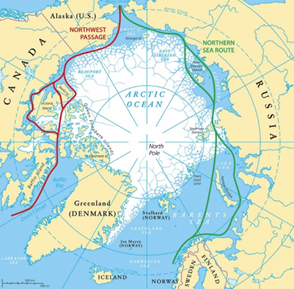
-
- Unlike the Atlantic and Pacific, the waters of the Eurasian Arctic Ocean get warmer as they get deeper.
- The top of the ocean is typically covered by sea ice. Below this is a layer of cool freshwater, followed by a deeper layer of warmer, saltier water delivered to the Arctic from the Atlantic by ocean currents.
- According to NASA data, the total area covered by sea ice in this region has fallen by almost half since 1980s.
- A possible reason for this is that, when sea ice melts through the summer, it replenishes the freshwater layer that sits above the warmer Atlantic layer.
- With less sea ice around, the amount of freshwater dwindles, this, in turn, causes the ocean to mix together, drawing more Atlantic heat up towards the surface.
- This “Atlantification” can, in turn, cause more ice to melt from below.
- Climate changedue to Anthropogenic factors has been accelerating the Atlantification process and this will in turn significantly affect the weather patterns, ocean circulations, and the entire Arctic ecosystem.
Consequences of the Warming
- Extreme weather: The exceptional warming of the Arctic could lead to more extreme weather in North America, Europe and Asia.
- The extreme weather events south of the Arctic are linked to the region’s warming through the Arctic jet stream.
- The jet stream that usually keeps the cold Arctic air within the region, due to excessive and rapid warming is causing it to become wavierdue to which, the cold air is interacting more frequently with the warm air from the lower latitudes, leading to extreme weather event.
- Rapid and voluminous melting of Ice: As the Arctic region warms, the sea ice melts and exposes the ocean surface below. The surface absorbs more energy than sea ice would have and enhances the warming, making more sea ice melt, forming a feedback loop.
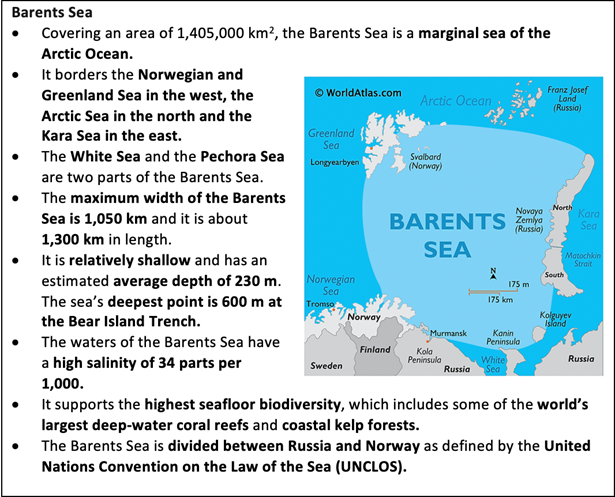
- First Recorded Rainfall at Summit Station Greenland: The rapid warming of the Arctic region has already thrown up weird weather such as the first recorded rainfall at the Summit Station of Greenlandin 2021 and back-to-back storms.
- Increased Lightning strikes: Lightning strikes,which were once rare in the region, have increased by eight times in the last decade.
- Adverse Impact on Marine Ecosystem: The warming of the region has resulted in the northward shift and increase in abundance of Atlantic fish speciesand a decrease in the endemic Arctic fish species.
- Extreme Snowfall: There has been an extreme snowfall event recorded, often dubbed as the ‘Beast from the East’, across most of Europe in 2018 which was a result of evaporation of over 140 gigatonnes of water from the Barents Sea that contributed to 88% of the snow that fell across Europe.
Source:
- Climate frontline: Barents Sea around Svalbard, Franz Josef Land warming 7 times faster than globe, says study
- Barents Sea around Svalbard, Franz Josef Land warming 7 times faster than globe, says study
Image source:
World Refugee Day - Edukemy Current Affairs
On June 20, every year, World Refugee Day is observed. It has been designated by the United Nations to honour refugees from around the world. The day celebrates the strength and courage of people who have been forced to flee their home country to escape conflict or persecution. Every minute 20 people leave everything behind to escape war, persecution or terror.
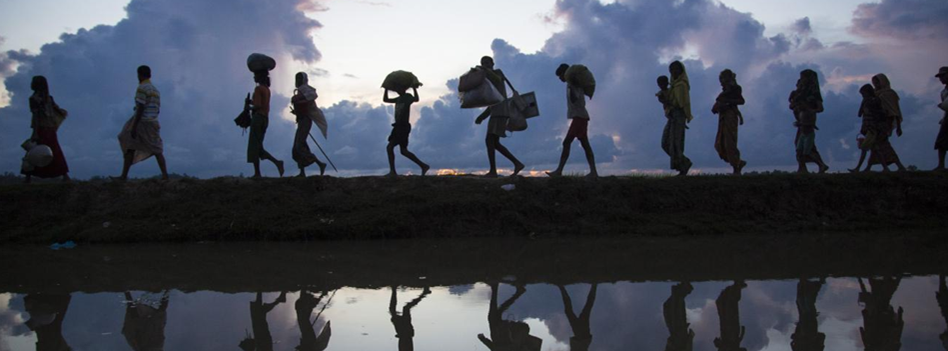
There are several types of forcibly displaced persons like Refugees, Asylum Seekers, Internally Displaced Persons (IDPs), Stateless Persons and Returnees. The 1951 Refugee Convention and its 1967 Protocol help protect them. The 1951 Convention contains a number of rights and also highlights the obligations of refugees towards their host country.
Sources:
First Steel Slag Road - Edukemy Current Affairs
- Context: Surat has become the first city in the country to get a processed steel slag (industrial waste) road.
- The six-lane public road is a joint-venture of the Council of Scientific and Industrial Research (CSIR), Central Road Research Institute (CRRI), Union Ministry of Steel, NITI Ayog, and Arcelor Mitttal-Nippon Steel (AM/NS).
- The thickness of the road is 30% lesser than normal ones, while its durability is much longer due to the utilization of steel slag.
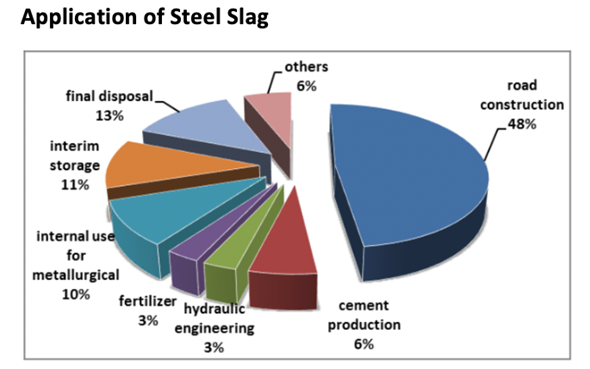
- This project falls under the initiative of the Waste to Wealth and Clean India Campaign.
- As steel slag in road construction ensures sustainable use of waste by reducing the reliance on perishable natural aggregates, it is a boon to India’s commitment to the UNSDG Goal- 9 for building resilient infrastructure.
- Steel slag is a by-product of steel making, produced during the separation of the molten steel from impurities in steel-making furnaces.
- Steel slags find application in the agricultural sector due to its ability to correct soil acidity.
- It contains nutrients for the plants and as silicate fertilizer, it is capable of providing silicon to the plants.
- As its use has lower carbon footprint, it finds major application in transportation industry, construction, cement production, wastewater and water treatment etc.
Source:
- Surat gets India’s first steel slag road: What is it, how is it different from regular ones? | CSIR - Central Road Research Institute (crridom.gov.in)
- Steel Slag - Material Description - User Guidelines for Waste and Byproduct Materials in Pavement Construction - FHWA-RD-97-148 (dot.gov)
- steel slag: India's first road constructed from steel slag inaugurated in Surat - The Economic Times (indiatimes.com)
- The Road to Sustainability: Using Steel Slag for Asphalt Roads – Official POSCO Newsroom
Image Source:
World Crocodile day - Edukemy Current Affairs
- Context: World Crocodile Day celebrated on 17th June, is a global awareness initiative to highlight the plight of endangered crocodiles and alligators.
- According to the experts, countries in southern Asia need to pull efforts to conserve the region’s three crocodilians, especially the critically endangered gharial.
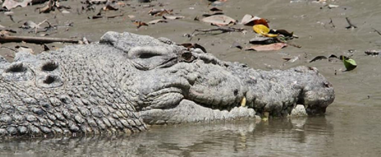
- India is home to three kinds of crocodiles:
- The mugger or marsh crocodile (most widespread and found in other South Asian countries too - Vulnerable; Schedule 1 of 1972)
- The estuarine or saltwater crocodile (found in Odisha’s Bhitarkanika National Park, the Sundarbans in West Bengal and the Andamans and Nicobar Islands - Least concern; Schedule 1 of WPA, 1972)
- The gharial (found mostly in Himalayan rivers - Critically Endangered; Schedule 1 of WPA, 1972)
- Human-Crocodile Conflict: Humans enchroachment on the river banks with an increased tourism and urbanization are the primary reasons for increasing human-crocodile conflict in the areas like - Vadodara in Gujarat, Kota in Rajasthan, Bhitarkanika in Odisha and the Andaman and Nicobar Islands.
- Sand mining, untreated domestic sewage and illegal fishing remains a major challenge to gharial conservation across southern Asia.
- Conservation measures: The Crocodile Conservation Project launched in 1975, resulted eventually in increase of Saltwater crocodile population in India.
- Transboundary cooperation is very much needed in south Asia. The gharial, along with the Ganges dolphin, was on the agenda of the CMS CoP13.
Source:
- This World Crocodile Day, South Asian countries should think of cooperating to conserve them: Experts (downtoearth.org.in)
- World Crocodile Day: Experts call for patience regarding human-croc conflict (downtoearth.org.in) Conservation of Wildlife in India, India Wildlife Conservation (indiaprofile.com)
Image Source:
- World Crocodile Day: Experts call for patience regarding human-croc conflict (downtoearth.org.in)
I2U2 initiative - Edukemy Current Affairs
- Context: The I2U2 initiative will hold its first virtual summit in July 2022.
- The new I2U2 initiative, 'I2' stands for India and Israel, whereas ‘U2’ for USA and the
- In October 2021, a meeting of the foreign ministers of the four countries took place when External Affairs of India was visiting Israel. At that time, it was called the ‘International Forum for Economic Cooperation’.
- The India-Israel-US-UAE grouping, which met for the first time under a new framework in October 2021, dealt with issues concerning maritime security, infrastructure, digital infrastructure and transport.
- After the Abraham Accords between Israel and the United Arab Emirates, I2U2 was founded in October 2021 aiming to address marine security, infrastructure, and transportation challenges in the region.
- India will be able to enhance its relationship with Israel without disturbing its ties with Arab countries like UAE through Abraham Accords.
- The I2U2 initiative is also coined as ‘West Asian Quad’.
Source:
Black Death (pandemic) - Edukemy Current Affairs
- Context: Researchers have claimed that the bubonic plague was originated in modern day northern Kyrgyzstan around 1338-1339.
- DNA from plague bacteria has been identified in graves from 1338 in Kyrgyzstan, and these pathogens appear to be the ancestors of those that caused the Black Death (Bubonic plague).
- The geographical origin point of the plague has been a debatable topic since centuries. The Black marks that appear on the plague victims’ body, makes this disease called as ‘Black Death’.
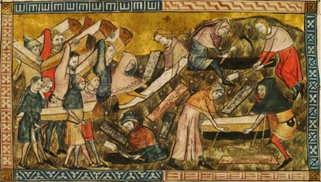
- Researchers agree that the Black Death, was caused by bacterium Yersinia pestis and was spread by fleas that were carried by rodent hosts.
- The onset of symptoms was followed by intense fever and vomiting of blood, where the victims died within 2-7 days.
Source:
- Black Death: Origin of pandemic traced to plague bacteria found in Kyrgyzstan graves | New Scientist
- Black Death - Black Death origins traced to plague in Kyrgyzstan - Telegraph India
- Black Death's ancient origins traced to lake in Central Asia - Los Angeles Times (latimes.com)
- Explained: The origins of Black Death, the deadliest pandemic recorded in history (firstpost.com)
- Black Death: DNA analysis reveals source of plague - CNN
Image Source:
An oil palm plan for home: Indian Express
Essence: Global trade is facing some complex issues like waiving of IPR on vaccines during health emergencies, limits on public stockholding for food security purposes, contentious subsidy, and e-commerce related problems etc.
Recently concluded 12th Ministerial Conference of WTO in Geneva could not arrive at consensus on such issues.
Inward looking behavior of countries in times of emergency like stopping export of palm oil by Malaysia have made the world paranoid about ensuring “self-sufficiency”. India is also planning steps to reduce excessive dependence on the global market for edible oil.
Authors conclude that these issues do not have any easy solution and holistic thinking and long-term vision is the only way out.
Why should you read this article?
- To understand issues plaguing global trade.
- To understand excessive import dependency faced by India in some food items.
Source:
To make jobs, don't bloat the bureaucracy: Economic Times
Essence: While recommending wage and pension increases for bureaucrats in 2015, the 7th Pay Commission stated that a lean state combined with an agile and young bureaucracy will assist provide public goods more effectively. GoI now plans to hire 1 million workers in the next 18 months, almost a third more than it already employs. This intervention is intended to address the job crisis, reverse the reform to reduce bureaucratic growth and will wreak havoc on government budgets.
The solution to the employment problem is to increase public investment and other departments, this will stimulate GDP and allow the private sector to recruit more people, hence increasing salaries and stimulating demand. An increase in recruiting is expected to worsen the operating ratio, leaving fewer resources available for capital investment. The financial repercussions of the Government of India's hiring drive cannot be ignored.
Why should you read this article?
- To comprehend how an agile and young bureaucracy may aid in the effective delivery of public goods.
- To learn about the solution to the employment shortfall that can assist promote growth.
Source:
Believing in ‘self-sufficiency’
Background
- Successive lockdowns and clampdowns in the erstwhile state of Jammu and Kashmir in the last three years have given a severe blow to the private sector, soaring the unemployment rate.
- Zamruda Bano, from Kulgam district in Jammu and Kashmir, has created a livelihood not only for herself but for others.

About the initiative of Zamruda Bano
- During the pandemic, Zamruda extended her knowledge of crewel embroidery to women of the valley who all earn a livelihood because of her.
- She had started the first centre in her village and over the years, Zamruda has established more than 100 centres, in scores of villages in Kulgam and Anantnag districts.
- She faced several problems initially, from financial constraints to marketing of products.
- In these centres, women are engaged in crewel embroidery and earn up to 5,000 orders a monthly.
- Zamruda believes in being self-sufficient and aims to provide jobs to underprivileged women who were not fortunate enough to receive a proper education.
- Today, products from these centres are sent to Srinagar and several other parts of the country such as New Delhi, Maharashtra, Gujarat and Bengaluru.
Source:
Share the article
Get Latest Updates on Offers, Event dates, and free Mentorship sessions.

Get in touch with our Expert Academic Counsellors 👋
FAQs
UPSC Daily Current Affairs focuses on learning current events on a daily basis. An aspirant needs to study regular and updated information about current events, news, and relevant topics that are important for UPSC aspirants. It covers national and international affairs, government policies, socio-economic issues, science and technology advancements, and more.
UPSC Daily Current Affairs provides aspirants with a concise and comprehensive overview of the latest happenings and developments across various fields. It helps aspirants stay updated with current affairs and provides them with valuable insights and analysis, which are essential for answering questions in the UPSC examinations. It enhances their knowledge, analytical skills, and ability to connect current affairs with the UPSC syllabus.
UPSC Daily Current Affairs covers a wide range of topics, including politics, economics, science and technology, environment, social issues, governance, international relations, and more. It offers news summaries, in-depth analyses, editorials, opinion pieces, and relevant study materials. It also provides practice questions and quizzes to help aspirants test their understanding of current affairs.
Edukemy's UPSC Daily Current Affairs can be accessed through:
- UPSC Daily Current Affairs can be accessed through Current Affairs tab at the top of the Main Page of Edukemy.
- Edukemy Mobile app: The Daily Current Affairs can also be access through Edukemy Mobile App.
- Social media: Follow Edukemy’s official social media accounts or pages that provide UPSC Daily Current Affairs updates, including Facebook, Twitter, or Telegram channels.

